Himanshu Thapliyal
Detection of Physiological Data Tampering Attacks with Quantum Machine Learning
Feb 09, 2025Abstract:The widespread use of cloud-based medical devices and wearable sensors has made physiological data susceptible to tampering. These attacks can compromise the reliability of healthcare systems which can be critical and life-threatening. Detection of such data tampering is of immediate need. Machine learning has been used to detect anomalies in datasets but the performance of Quantum Machine Learning (QML) is still yet to be evaluated for physiological sensor data. Thus, our study compares the effectiveness of QML for detecting physiological data tampering, focusing on two types of white-box attacks: data poisoning and adversarial perturbation. The results show that QML models are better at identifying label-flipping attacks, achieving accuracy rates of 75%-95% depending on the data and attack severity. This superior performance is due to the ability of quantum algorithms to handle complex and high-dimensional data. However, both QML and classical models struggle to detect more sophisticated adversarial perturbation attacks, which subtly alter data without changing its statistical properties. Although QML performed poorly against this attack with around 45%-65% accuracy, it still outperformed classical algorithms in some cases.
Quantum Hybrid Support Vector Machines for Stress Detection in Older Adults
Jan 08, 2025Abstract:Stress can increase the possibility of cognitive impairment and decrease the quality of life in older adults. Smart healthcare can deploy quantum machine learning to enable preventive and diagnostic support. This work introduces a unique technique to address stress detection as an anomaly detection problem that uses quantum hybrid support vector machines. With the help of a wearable smartwatch, we mapped baseline sensor reading as normal data and stressed sensor reading as anomaly data using cortisol concentration as the ground truth. We have used quantum computing techniques to explore the complex feature spaces with kernel-based preprocessing. We illustrate the usefulness of our method by doing experimental validation on 40 older adults with the help of the TSST protocol. Our findings highlight that using a limited number of features, quantum machine learning provides improved accuracy compared to classical methods. We also observed that the recall value using quantum machine learning is higher compared to the classical method. The higher recall value illustrates the potential of quantum machine learning in healthcare, as missing anomalies could result in delayed diagnostics or treatment.
Anomaly Detection for Real-World Cyber-Physical Security using Quantum Hybrid Support Vector Machines
Sep 08, 2024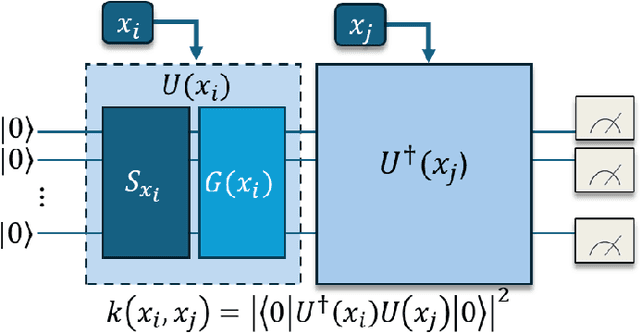
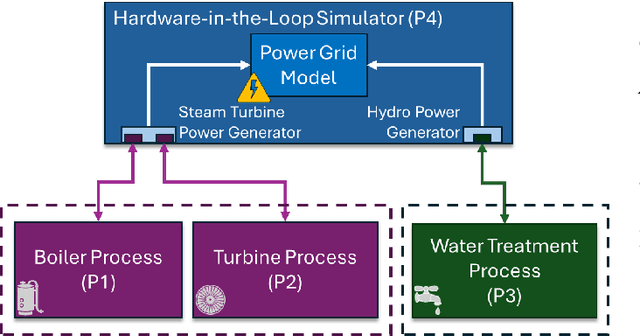
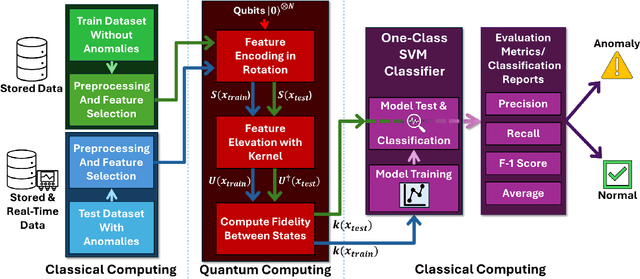
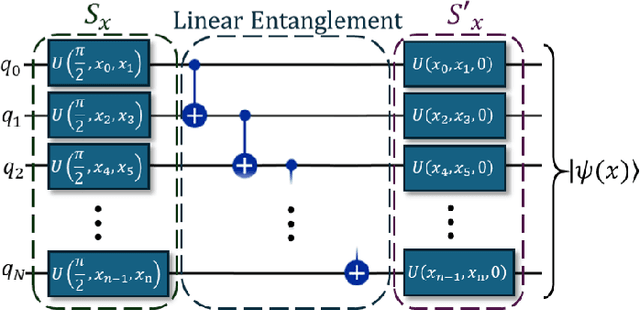
Abstract:Cyber-physical control systems are critical infrastructures designed around highly responsive feedback loops that are measured and manipulated by hundreds of sensors and controllers. Anomalous data, such as from cyber-attacks, greatly risk the safety of the infrastructure and human operators. With recent advances in the quantum computing paradigm, the application of quantum in anomaly detection can greatly improve identification of cyber-attacks in physical sensor data. In this paper, we explore the use of strong pre-processing methods and a quantum-hybrid Support Vector Machine (SVM) that takes advantage of fidelity in parameterized quantum circuits to efficiently and effectively flatten extremely high dimensional data. Our results show an F-1 Score of 0.86 and accuracy of 87% on the HAI CPS dataset using an 8-qubit, 16-feature quantum kernel, performing equally to existing work and 14% better than its classical counterpart.
Quantum Machine Learning for Anomaly Detection in Consumer Electronics
Aug 30, 2024


Abstract:Anomaly detection is a crucial task in cyber security. Technological advancement brings new cyber-physical threats like network intrusion, financial fraud, identity theft, and property invasion. In the rapidly changing world, with frequently emerging new types of anomalies, classical machine learning models are insufficient to prevent all the threats. Quantum Machine Learning (QML) is emerging as a powerful computational tool that can detect anomalies more efficiently. In this work, we have introduced QML and its applications for anomaly detection in consumer electronics. We have shown a generic framework for applying QML algorithms in anomaly detection tasks. We have also briefly discussed popular supervised, unsupervised, and reinforcement learning-based QML algorithms and included five case studies of recent works to show their applications in anomaly detection in the consumer electronics field.
Quantum Annealing for Automated Feature Selection in Stress Detection
Jun 09, 2021



Abstract:We present a novel methodology for automated feature subset selection from a pool of physiological signals using Quantum Annealing (QA). As a case study, we will investigate the effectiveness of QA-based feature selection techniques in selecting the optimal feature subset for stress detection. Features are extracted from four signal sources: foot EDA, hand EDA, ECG, and respiration. The proposed method embeds the feature variables extracted from the physiological signals in a binary quadratic model. The bias of the feature variable is calculated using the Pearson correlation coefficient between the feature variable and the target variable. The weight of the edge connecting the two feature variables is calculated using the Pearson correlation coefficient between two feature variables in the binary quadratic model. Subsequently, D-Wave's clique sampler is used to sample cliques from the binary quadratic model. The underlying solution is then re-sampled to obtain multiple good solutions and the clique with the lowest energy is returned as the optimal solution. The proposed method is compared with commonly used feature selection techniques for stress detection. Results indicate that QA-based feature subset selection performed equally as that of classical techniques. However, under data uncertainty conditions such as limited training data, the performance of quantum annealing for selecting optimum features remained unaffected, whereas a significant decrease in performance is observed with classical feature selection techniques. Preliminary results show the promise of quantum annealing in optimizing the training phase of a machine learning classifier, especially under data uncertainty conditions.
Machine Learning Based Prediction of Future Stress Events in a Driving Scenario
Jun 08, 2021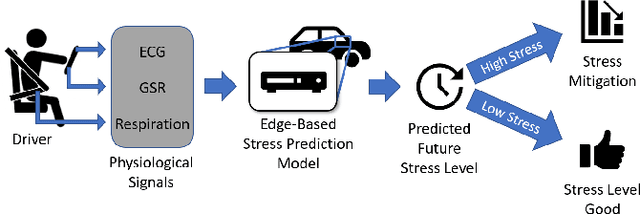
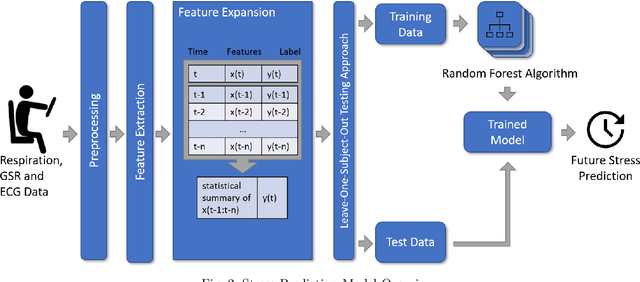
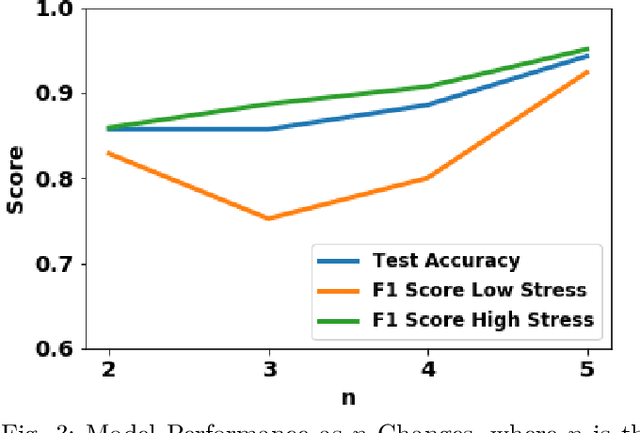
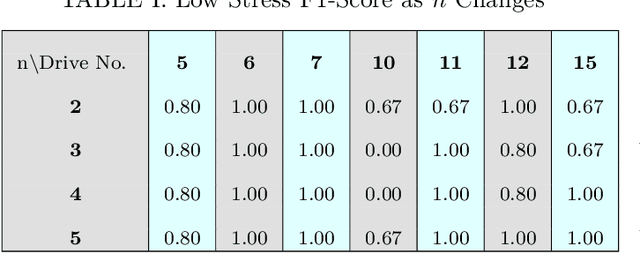
Abstract:This paper presents a model for predicting a driver's stress level up to one minute in advance. Successfully predicting future stress would allow stress mitigation to begin before the subject becomes stressed, reducing or possibly avoiding the performance penalties of stress. The proposed model takes features extracted from Galvanic Skin Response (GSR) signals on the foot and hand and Respiration and Electrocardiogram (ECG) signals from the chest of the driver. The data used to train the model was retrieved from an existing database and then processed to create statistical and frequency features. A total of 42 features were extracted from the data and then expanded into a total of 252 features by grouping the data and taking six statistical measurements of each group for each feature. A Random Forest Classifier was trained and evaluated using a leave-one-subject-out testing approach. The model achieved 94% average accuracy on the test data. Results indicate that the model performs well and could be used as part of a vehicle stress prevention system.
Machine Learning Based Anxiety Detection in Older Adults using Wristband Sensors and Context Feature
Jun 06, 2021



Abstract:This paper explores a novel method for anxiety detection in older adults using simple wristband sensors such as Electrodermal Activity (EDA) and Photoplethysmogram (PPG) and a context-based feature. The proposed method for anxiety detection combines features from a single physiological signal with an experimental context-based feature to improve the performance of the anxiety detection model. The experimental data for this work is obtained from a year-long experiment on 41 healthy older adults (26 females and 15 males) in the age range 60-80 with mean age 73.36+-5.25 during a Trier Social Stress Test (TSST) protocol. The anxiety level ground truth was obtained from State-Trait Anxiety Inventory (STAI), which is regarded as the gold standard to measure perceived anxiety. EDA and Blood Volume Pulse (BVP) signals were recorded using a wrist-worn EDA and PPG sensor respectively. 47 features were computed from EDA and BVP signal, out of which a final set of 24 significantly correlated features were selected for analysis. The phases of the experimental study are encoded as unique integers to generate the context feature vector. A combination of features from a single sensor with the context feature vector is used for training a machine learning model to distinguish between anxious and not-anxious states. Results and analysis showed that the EDA and BVP machine learning models that combined the context feature along with the physiological features achieved 3.37% and 6.41% higher accuracy respectively than the models that used only physiological features. Further, end-to-end processing of EDA and BVP signals was simulated for real-time anxiety level detection. This work demonstrates the practicality of the proposed anxiety detection method in facilitating long-term monitoring of anxiety in older adults using low-cost consumer devices.
* 13 pages
A Review of Machine Learning Classification Using Quantum Annealing for Real-world Applications
Jun 05, 2021



Abstract:Optimizing the training of a machine learning pipeline helps in reducing training costs and improving model performance. One such optimizing strategy is quantum annealing, which is an emerging computing paradigm that has shown potential in optimizing the training of a machine learning model. The implementation of a physical quantum annealer has been realized by D-Wave systems and is available to the research community for experiments. Recent experimental results on a variety of machine learning applications using quantum annealing have shown interesting results where the performance of classical machine learning techniques is limited by limited training data and high dimensional features. This article explores the application of D-Wave's quantum annealer for optimizing machine learning pipelines for real-world classification problems. We review the application domains on which a physical quantum annealer has been used to train machine learning classifiers. We discuss and analyze the experiments performed on the D-Wave quantum annealer for applications such as image recognition, remote sensing imagery, computational biology, and particle physics. We discuss the possible advantages and the problems for which quantum annealing is likely to be advantageous over classical computation.
* 13 Pages
 Add to Chrome
Add to Chrome Add to Firefox
Add to Firefox Add to Edge
Add to Edge